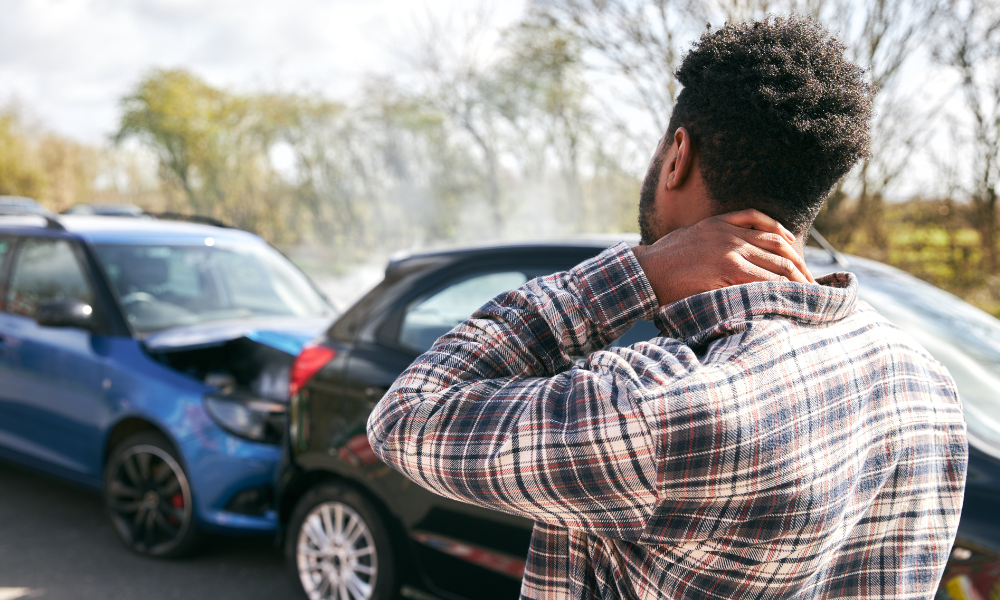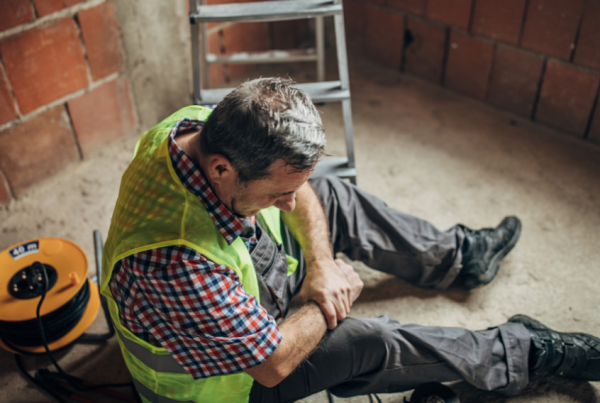Car Accident Injuries
Move Better. Live Fuller. Your Wellness Journey Starts Here.
Schedule a FREE Discovery Call!
About Car Accident Injuries
Car accident injuries refer to a variety of injuries caused by the collision of a vehicle with other vehicles or objects. This sudden and forceful impact can injure practically any part of the body—often affecting bones, soft tissues, organs, and other structures. These injuries can range widely from mild to very severe.
Many car accident injuries affect the musculoskeletal system, meaning physical therapists play a significant role in recovery and rehabilitation. Injuries often occur to the back, neck, wrists, hands, hips, pelvis, ribs, knees, legs, shoulders, and more. In terms of symptoms, car accident injuries can cause:
- Pain
- Dysfunction
- Reduced mobility
- Swelling
- Stiffness
- Numbness or tingling
- And more

For some severe injuries, surgical methods may be deemed necessary. Physical therapy will be absolutely essential in cases involving surgery, as it aims to restore normal movement and function. However, the severity of a car accident injury depends on the accident itself. There are many different variables and aspects of a crash that can create injury, such as the following:
- Sudden and direct impact
- Rapid movement or changes in movement
- Significant force
- Harmful or unnatural postures
- Failure to use a seatbelt
- Deployment of an airbag
Common Types of Car Accident Injuries
Car accidents are unpredictable and have many different variables that impact the crash. Due to this, car accident injuries can affect practically any part of the body and can vary widely in type and severity. However, due to the nature of most car accidents, there are some types of injuries that are more common or likely.
Below, we’ve listed some common car accident injuries where a physical therapist can provide treatment or support during recovery:
Spinal Injuries
These injuries often happen in car accidents and can range from mild to life-threatening. These injuries can affect an individual’s ability to walk or move. One very common type is whiplash, but other types of spinal injuries can include herniated discs, fractures, joint injuries, spinal stenosis, and spinal cord injuries.
Whiplash
Whiplash is an injury of the upper spine and neck area. It is caused by sudden movement and a force of inertia on the neck, causing a sprain or injury to the area. This injury can be graded by its severity, and depending on the severity may cause stiffness, pain, sensitivity, or neurological problems.
Headaches
Headaches occur after car accidents for a variety of reasons. Direct injury, herniated discs, whiplash, neck strain, and other causes can create headaches. Headaches are a common experience after car crashes, but should never be ignored, as they can be indicative of a serious condition.
Low Back Pain
Many parts of the spine experience stress during accidents and vehicle crashes, therefore low back pain is a common symptom. The lower back (lumbar region) may experience pain, stiffness, numbness, and other symptoms that may make it difficult to stand or walk. These issues can be caused by slipped discs, sprains, strains, fractures, and spinal cord injuries.
Fractures
Fractures can occur in many areas of the body during a car accident. The wrists, hands, pelvis, hips, vertebrae, arms, legs, ribs, and other areas are susceptible to direct impact, which can cause fractures.
Dislocations
A dislocation is an injury to a joint. It occurs when the bones move out of their normal position and causes pain, immobility, instability, and dysfunction. Dislocations in car accident injuries often occur to the shoulders, elbows, wrists, knees, hips, and other areas.
Strains or Sprains
The excess force experienced during car accidents can jolt the body, which may overstretch soft tissues (muscles, ligaments, tendons) and cause injury. The neck and back are especially susceptible to sprains and strains.
Chronic Pain Syndrome
Chronic pain refers to pain that is persistent, recurrent, and long-lasting—typically lasting longer than three months. In some cases, car accident injuries can become chronic injuries if not treated or rehabilitated properly.
Physical Therapy for Car Accident Injuries
Car accident injuries can significantly impact an individual’s life. It is very important to receive sufficient care after such an experience in order to prevent long-term complications, pain, or dysfunction. Physical therapists are skilled in evaluating your injury, relieving your pain, improving function, and reducing the risk of future complications through education and preventative treatments.
When receiving treatment at Hive Therapy and Wellness for a car accident injury, you’ll first experience a process of evaluation and examination. This process will include aspects such as the following:
- Discussion of your symptoms, pain, and any impairments to daily life or specific tasks.
- Discussing the nature of the incident and how it occurred, which is necessary to better understand the effect of certain forces and direct impact.
- Physical examination of the injury to assess pain, swelling, inflammation, and other factors like range of motion, function, and strength.
- Physical tests to assess balance, stability, and coordination.
After your physical therapist has conducted a thorough evaluation, they’ll formulate a care plan based on your results. This care plan may include treatments such as the examples below:
Pain Management
Pain is a common complaint after car accidents. Fractures, sprains, strains, and other injuries can cause pain as well as swelling, stiffness, and discomfort. At Hive Therapy and Wellness, you can receive a variety of pain-relieving treatments that are appropriate for both your injury and stage of healing.
Some examples include therapeutic modalities such as temperature therapy, electric muscle stimulation, or laser therapy. These modalities manage pain and swelling, and are useful when combined with other treatments, too.
Another form of pain management is manual therapy, a physical technique that utilizes tools or your provider’s hands to manipulate and mobilize soft tissues. This not only manages pain, but also provides the added benefits of improved blood flow, muscle function, tissue mobility, and more. Some common manual therapy techniques used at Hive include dry needling, cupping, and tissue scraping.
Neuromuscular Re-Education
Neuromuscular re-education will be very important for a variety of car accident injuries. Oftentimes after injury, the affected area can become stiff and less mobile. Performing normal daily tasks may become a struggle when mobility is limited and dysfunction is present. When the affected area is the back or neck, this affects practically any movement.
Neuromuscular re-education serves as a form of movement retraining, helping you learn to move your body efficiently and correctly again after injury. It can improve coordination, prevent harmful compensatory patterns, and allow you to move freely again as you recover. Your physical therapist will lead you through a variety of activities to correct your posture, movement mechanics, and form.
Restoring Mobility and Strength
With any injury, the affected area can become weak, stiff, immobile, and unable to perform normal function. As you heal and relearn correct movement patterns, your provider will also lead you through strengthening exercises and mobility practice to restore normal function to your injured area. This can vary based on the location and severity of your injury, but will typically start out gentle and gradually increase in difficulty as your recovery progresses.
These exercises can include aspects such as:
- Strengthening the injured area and surrounding muscle groups
- Gentle stretching to improve flexibility
- Range of motion exercises
- Practicing activities of daily living (ADLs) such as lifting, bending, etc.
- And more
Education and Long-Term Care
An important part of treatment for car accident injuries is education and maintenance. As you recover, your physical therapist can suggest modifications to your activities to protect your injury. They will teach you strategies to maintain good posture and prevent compensatory movement patterns.
This type of education is important in order to prevent re-injury and to support effective healing. They’ll formulate an exercise and stretching plan to support your healing while at home, too! As you heal and progress through your recovery journey, your physical therapist will adjust your care plan to best restore your movement, function, and comfort.
As mentioned before, car accident injuries can range widely. In some cases, serious conditions or injuries may result from these types of accidents. In such cases, a multidisciplinary treatment approach may be necessary. The providers at Hive Therapy and Wellness understand the importance of collaborative treatment, and are always ready to work with other healthcare professionals as needed for your care!
The physical therapists at Hive are determined to support your long-term health goals, independence, and comfort! To ensure you properly recover and can return to a high quality of life after a car accident injury, your physical therapist will utilize a variety of treatments that best encourage recovery and prevent long-term complications. These treatments may include any of the above-mentioned examples, as well as the following:
- Neuromuscular re-education
- Manual therapy
- Exercise prescription
- Dry needling
- Cupping
- Tissue scraping
- Behavioral modifications
- Therapeutic activities
- Electrical muscle stimulation
- Spinal manipulation
- Therapeutic modalities
- Biofeedback
Car accident injuries refer to a variety of injuries caused by the collision of a vehicle with other vehicles or objects.
This sudden and forceful impact can injure practically any part of the body—often affecting bones, soft tissues, organs, and other structures. These injuries can range widely from mild to very severe.
Many car accident injuries affect the musculoskeletal system, meaning physical therapists play a significant role in recovery and rehabilitation.
Injuries often occur to the back, neck, wrists, hands, hips, pelvis, ribs, knees, legs, shoulders, and more. In terms of symptoms, car accident injuries can cause:
- Pain
- Dysfunction
- Reduced mobility
- Swelling
- Stiffness
- Numbness or tingling
- And more
For some severe injuries, surgical methods may be deemed necessary. Physical therapy will be absolutely essential in cases involving surgery, as it aims to restore normal movement and function.
However, the severity of a car accident injury depends on the accident itself. There are many different variables and aspects of a crash that can create injury, such as the following:
- Sudden and direct impact
- Rapid movement or changes in movement
- Significant force
- Harmful or unnatural postures
- Failure to use a seatbelt
- Deployment of an airbag
Car accidents are unpredictable and have many different variables that impact the crash. Due to this, car accident injuries can affect practically any part of the body and can vary widely in type and severity.
However, due to the nature of most car accidents, there are some types of injuries that are more common or likely.
Below, we’ve listed some common car accident injuries where a physical therapist can provide treatment or support during recovery:
Spinal Injuries
These injuries often happen in car accidents and can range from mild to life-threatening. These injuries can affect an individual’s ability to walk or move.
One very common type is whiplash, but other types of spinal injuries can include herniated discs, fractures, joint injuries, spinal stenosis, and spinal cord injuries.
Whiplash
Whiplash is an injury of the upper spine and neck area. It is caused by sudden movement and a force of inertia on the neck, causing a sprain or injury to the area.
This injury can be graded by its severity, and depending on the severity may cause stiffness, pain, sensitivity, or neurological problems.
Headaches
Headaches occur after car accidents for a variety of reasons. Direct injury, herniated discs, whiplash, neck strain, and other causes can create headaches.
Headaches are a common experience after car crashes, but should never be ignored, as they can be indicative of a serious condition.
Low Back Pain
Many parts of the spine experience stress during accidents and vehicle crashes, therefore low back pain is a common symptom.
The lower back (lumbar region) may experience pain, stiffness, numbness, and other symptoms that may make it difficult to stand or walk. These issues can be caused by slipped discs, sprains, strains, fractures, and spinal cord injuries.
Fractures
Fractures can occur in many areas of the body during a car accident. The wrists, hands, pelvis, hips, vertebrae, arms, legs, ribs, and other areas are susceptible to direct impact, which can cause fractures.
Dislocations
A dislocation is an injury to a joint. It occurs when the bones move out of their normal position and causes pain, immobility, instability, and dysfunction.
Dislocations in car accident injuries often occur to the shoulders, elbows, wrists, knees, hips, and other areas.
Strains or Sprains
The excess force experienced during car accidents can jolt the body, which may overstretch soft tissues (muscles, ligaments, tendons) and cause injury. The neck and back are especially susceptible to sprains and strains.
Chronic Pain Syndrome
Chronic pain refers to pain that is persistent, recurrent, and long-lasting—typically lasting longer than three months. In some cases, car accident injuries can become chronic injuries if not treated or rehabilitated properly.
Car accident injuries can significantly impact an individual’s life. It is very important to receive sufficient care after such an experience in order to prevent long-term complications, pain, or dysfunction.
Physical therapists are skilled in evaluating your injury, relieving your pain, improving function, and reducing the risk of future complications through education and preventative treatments.
When receiving treatment at Hive Therapy and Wellness for a car accident injury, you’ll first experience a process of evaluation and examination. This process will include aspects such as the following:
- Discussion of your symptoms, pain, and any impairments to daily life or specific tasks.
- Discussing the nature of the incident and how it occurred, which is necessary to better understand the effect of certain forces and direct impact.
- Physical examination of the injury to assess pain, swelling, inflammation, and other factors like range of motion, function, and strength.
- Physical tests to assess balance, stability, and coordination.
After your physical therapist has conducted a thorough evaluation, they’ll formulate a care plan based on your results. This care plan may include treatments such as the examples below:
Pain Management
Pain is a common complaint after car accidents. Fractures, sprains, strains, and other injuries can cause pain as well as swelling, stiffness, and discomfort.
At Hive Therapy and Wellness, you can receive a variety of pain-relieving treatments that are appropriate for both your injury and stage of healing.
Some examples include therapeutic modalities such as temperature therapy, electric muscle stimulation, or laser therapy. These modalities manage pain and swelling, and are useful when combined with other treatments, too.
Another form of pain management is manual therapy, a physical technique that utilizes tools or your provider’s hands to manipulate and mobilize soft tissues.
This not only manages pain, but also provides the added benefits of improved blood flow, muscle function, tissue mobility, and more.
Some common manual therapy techniques used at Hive include dry needling, cupping, and tissue scraping.
Neuromuscular Re-Education
Neuromuscular re-education will be very important for a variety of car accident injuries. Oftentimes after injury, the affected area can become stiff and less mobile.
Performing normal daily tasks may become a struggle when mobility is limited and dysfunction is present. When the affected area is the back or neck, this affects practically any movement.
Neuromuscular re-education serves as a form of movement retraining, helping you learn to move your body efficiently and correctly again after injury.
It can improve coordination, prevent harmful compensatory patterns, and allow you to move freely again as you recover.
Your physical therapist will lead you through a variety of activities to correct your posture, movement mechanics, and form.
Restoring Mobility and Strength
With any injury, the affected area can become weak, stiff, immobile, and unable to perform normal function.
As you heal and relearn correct movement patterns, your provider will also lead you through strengthening exercises and mobility practice to restore normal function to your injured area.
This can vary based on the location and severity of your injury, but will typically start out gentle and gradually increase in difficulty as your recovery progresses.
These exercises can include aspects such as:
- Strengthening the injured area and surrounding muscle groups
- Gentle stretching to improve flexibility
- Range of motion exercises
- Practicing activities of daily living (ADLs) such as lifting, bending, etc.
- And more
Education and Long-Term Care
An important part of treatment for car accident injuries is education and maintenance. As you recover, your physical therapist can suggest modifications to your activities to protect your injury.
They will teach you strategies to maintain good posture and prevent compensatory movement patterns.
This type of education is important in order to prevent re-injury and to support effective healing. They’ll formulate an exercise and stretching plan to support your healing while at home, too!
As you heal and progress through your recovery journey, your physical therapist will adjust your care plan to best restore your movement, function, and comfort.
As mentioned before, car accident injuries can range widely. In some cases, serious conditions or injuries may result from these types of accidents. In such cases, a multidisciplinary treatment approach may be necessary.
The providers at Hive Therapy and Wellness understand the importance of collaborative treatment, and are always ready to work with other healthcare professionals as needed for your care!
The physical therapists at Hive are determined to support your long-term health goals, independence, and comfort!
To ensure you properly recover and can return to a high quality of life after a car accident injury, your physical therapist will utilize a variety of treatments that best encourage recovery and prevent long-term complications.
These treatments may include any of the above-mentioned examples, as well as the following:
- Neuromuscular re-education
- Manual therapy
- Exercise prescription
- Dry needling
- Cupping
- Tissue scraping
- Behavioral modifications
- Therapeutic activities
- Electrical muscle stimulation
- Spinal manipulation
- Therapeutic modalities
- Biofeedback
You can learn more about these treatments on our Treatments Page.





